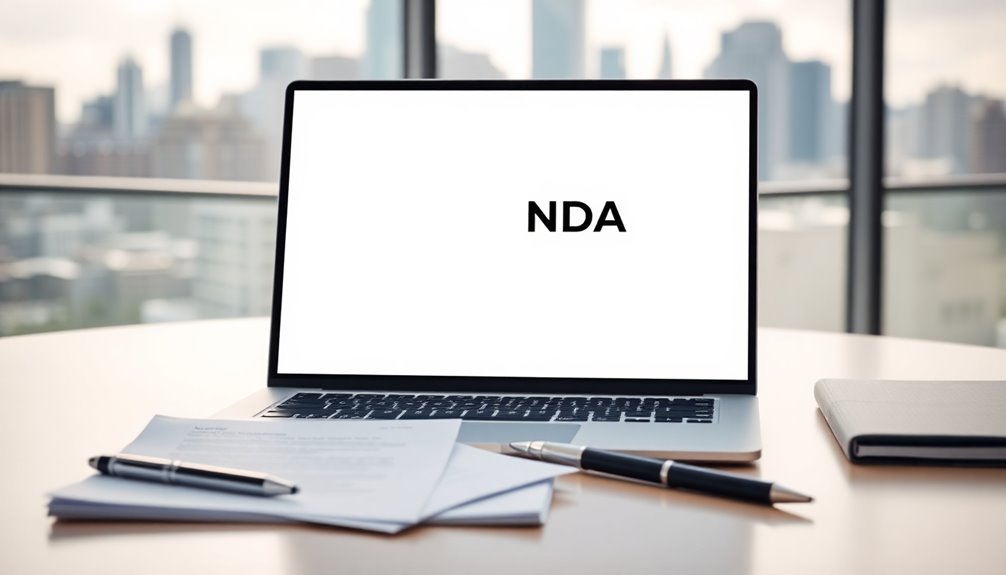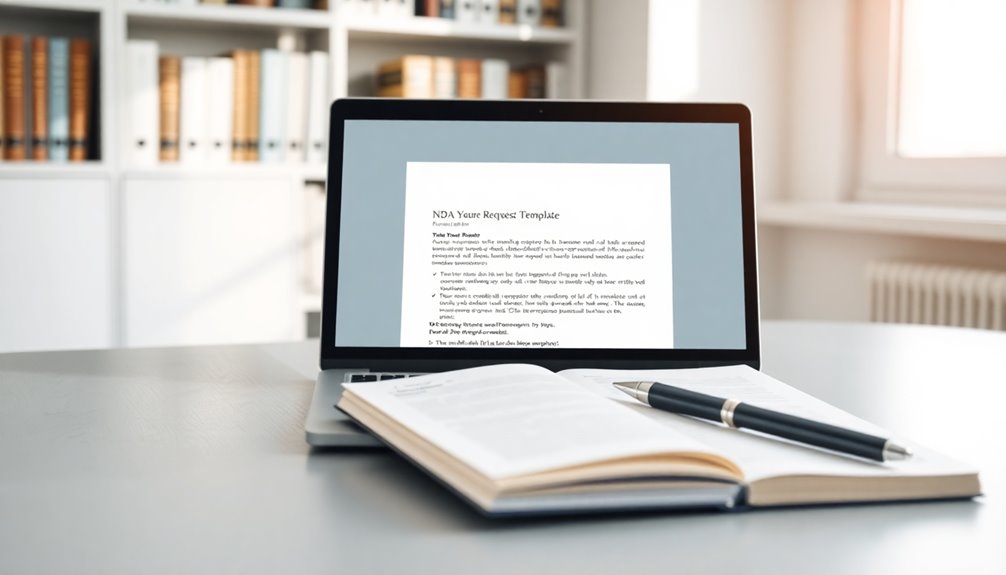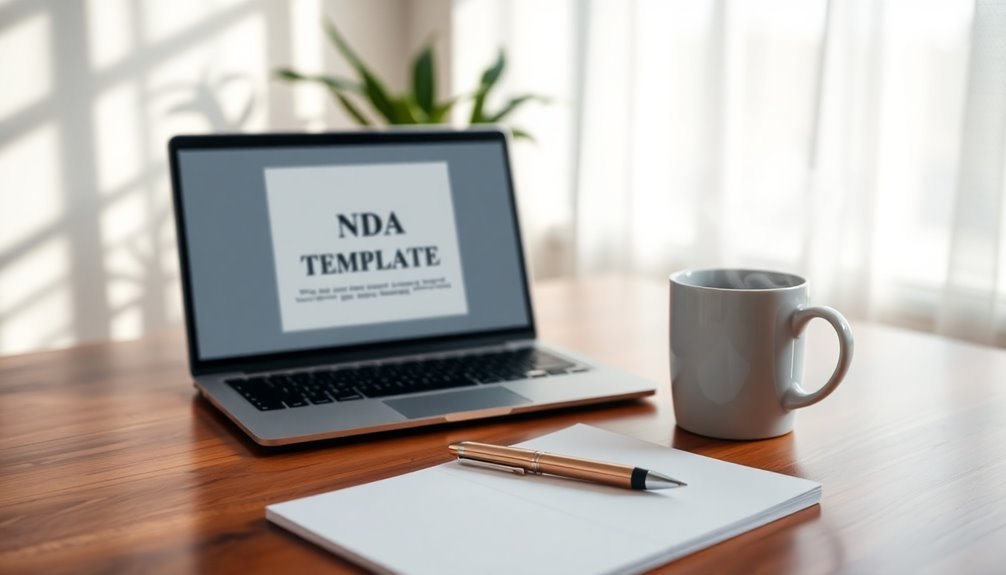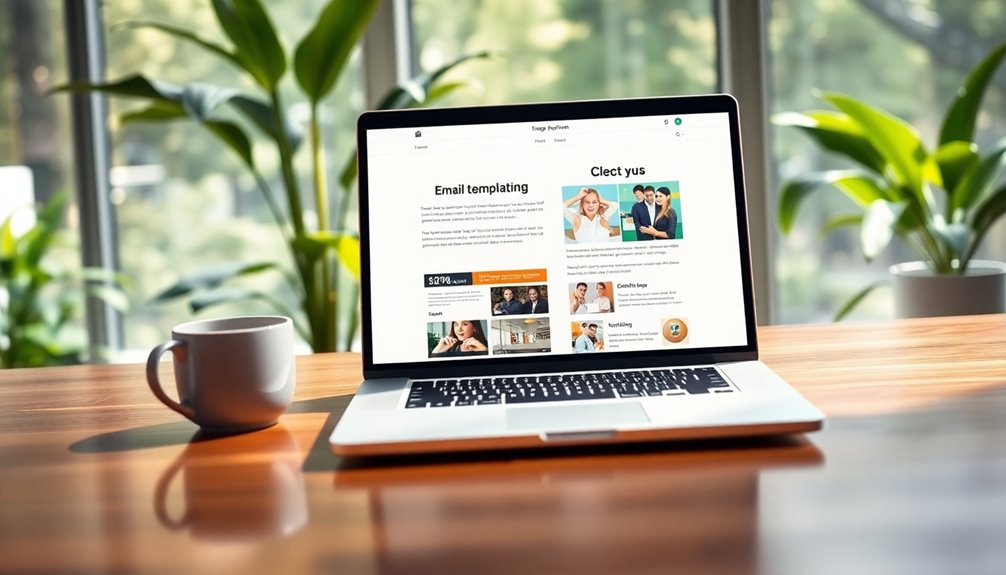To create an effective NDA email for confidentiality agreements, start with a clear subject line and define the confidential information upfront. Attach the NDA document for easy access and specify a signing deadline. Use a professional tone to convey urgency and outline both parties' obligations. Remember to clarify what happens in case of breaches and include contact details for all involved. Avoid common mistakes, like neglecting to define terms or specifying duration. This approach streamlines the process and builds trust. Keep going to discover tips and a sample NDA email template to simplify your communication further!
Key Takeaways
- Start with a clear statement of purpose, defining the confidential information to avoid ambiguity in the NDA email.
- Specify a deadline for signing the NDA to encourage prompt responses and expedite the process.
- Attach the NDA document as a PDF to preserve formatting and make it easily accessible for review.
- Use a professional tone and customize the email template with specific details for clarity and urgency.
- Follow up after a few days to confirm receipt, address any questions, and reinforce the importance of the agreement.
Introduction

In today's fast-paced business environment, having a clear and professional way to request confidentiality is essential. This is where an NDA email template comes in handy. By using a structured guide for requesting signatures on Confidentiality Agreements, you ensure that all relevant information is communicated effectively.
When you send an NDA, you're not just protecting confidential information; you're also establishing trust between all parties involved.
Using a well-crafted NDA email template streamlines the process, saving you time and reducing the chances of errors. It's crucial to present your request professionally, especially in contexts such as job interviews, business partnerships, or legal settlements. This approach fosters secure business relationships and enhances compliance with confidentiality requirements.
An NDA email template serves as a tool that helps you clearly articulate your need for a Confidentiality Agreement, making it easier for the recipient to understand the importance of the request.
Protects Sensitive Business Information

Protecting sensitive business information is a top priority for any organization. A Non-Disclosure Agreement (NDA) plays a crucial role in safeguarding this sensitive information by establishing a clear framework for confidentiality.
When you share data with partners or collaborators, an NDA ensures that everyone understands what constitutes confidential information, reducing ambiguity and enhancing the protection of your trade secrets and proprietary data.
By setting confidentiality obligations, NDAs foster a strong confidential relationship between businesses, which is essential for successful collaborations. Trust is vital, and knowing that your sensitive information is protected allows you to focus on innovation and growth without fearing unauthorized disclosure.
This is especially important in sectors like technology, healthcare, and finance, where compliance with legal and regulatory requirements is paramount.
Furthermore, utilizing NDAs can help you maintain a competitive edge by preventing competitors from accessing your operational strategies and innovations.
In a rapidly changing business landscape, protecting your sensitive information isn't just a precaution; it's a strategic advantage that can significantly impact your organization's success.
Clear Subject Line

A clear subject line is essential when sending an NDA email, as it immediately conveys the email's purpose. You should aim for a subject that explicitly states what the email is about, such as "Confidentiality Agreement for Review and Signature." This way, the recipient knows right away what to expect.
Including the term "NDA" emphasizes the importance and urgency of the confidentiality agreement being discussed.
Keep your subject line concise, ideally under 50 characters, to help the recipient quickly grasp the priority of your email amidst their busy inbox.
Using keywords like "Confidential," "Agreement," and "Signature Requested" enhances clarity and encourages timely action. You want to ensure your email stands out, so a well-crafted subject line reduces the chances of your message being overlooked or categorized as spam. Additionally, a clear budget allows you to allocate resources effectively, ensuring you can meet any potential legal obligations related to the NDA.
Crafting Your NDA Email

Crafting an effective NDA email requires a clear approach that highlights the importance of confidentiality. Start by stating the purpose of the email and specifying the confidential information it relates to. This ensures that recipients grasp the significance of the Non-Disclosure Agreement (NDA) and understand what's at stake.
Next, define what constitutes confidential information within the NDA. This avoids ambiguity and sets clear expectations for both parties involved.
Don't forget to provide a deadline for signing the NDA—this expedites the process and maintains a professional timeline for information exchange.
Attach the NDA document to the email, making it easily accessible for review and signing. This simple step can streamline the collaboration and encourage prompt responses.
Pro Tips for Maximizing Impact

Maximizing the impact of your NDA email can significantly enhance the likelihood of a swift response. Start by customizing the NDA email template with specific details about the sensitive information shared and the parties involved. This ensures clarity and relevance, making it easier for recipients to understand the importance of the Non-Disclosure Agreement (NDA).
A clear subject line, like "Confidentiality Agreement Request," grabs attention and conveys the email's purpose right away.
In the body, maintain a professional and concise tone. Briefly explain why the NDA is necessary and how it serves as a protective measure for both parties.
Don't forget to attach the NDA document as a PDF. This format preserves the document's layout and makes it easy for recipients to review and sign.
After sending your email, consider following up a few days later. This shows your commitment and provides an opportunity to confirm receipt and address any questions about the NDA.
Common Mistakes to Avoid

Sending an NDA email can be straightforward, but several common mistakes can undermine its effectiveness. One major pitfall is failing to clearly define what constitutes "Confidential Information." Without this clarity, sensitive data might get exposed to unauthorized parties, leading to potential breaches.
Another mistake is neglecting to specify the duration of the NDA, which can create ambiguity about how long the confidentiality obligations last.
You also want to include the consequences of a breach; without them, you weaken the agreement's enforceability, making it less likely to deter violations.
Additionally, don't forget to include the contact information of all parties involved. Omitting this can lead to difficulties in communication and enforcement of the agreement.
Lastly, using a generic template without customizing it to your specific context can leave critical nuances unaddressed, risking the NDA's overall effectiveness as a legally binding contract.
NDA Request Email Template

When you need to request a Non-Disclosure Agreement (NDA), it's crucial to communicate your intentions clearly and professionally.
Start your email by stating the purpose of the NDA, emphasizing the need to protect sensitive data that you'll share. Introduce yourself as the Disclosing Party, and mention the Receiving Party to provide context.
Clearly outline the information that requires protection, and explain why confidentiality is vital to your business relationship.
Highlight the legal implications of the NDA, ensuring the recipient understands the seriousness of the agreement.
Don't forget to attach the NDA document for their review. This makes it easier for them to understand the terms before signing.
In your email, you might say, "I've attached a draft of the Non-Disclosure Agreement for your consideration. Please review it at your earliest convenience."
Final Thoughts

Crafting an effective NDA email template is essential for establishing trust and protecting your sensitive information. By clearly stating the purpose of the Non-Disclosure Agreement (NDA) and emphasizing the importance of safeguarding confidential data, you lay the groundwork for a solid agreement.
Including a definition section helps eliminate ambiguity by specifying what qualifies as confidential information, ensuring everyone is on the same page.
It's also crucial to outline the duration of confidentiality to clarify how long the NDA will remain in effect. This protects shared information and sets expectations for both parties.
Additionally, your template should address the consequences of any breach, including potential legal action or financial penalties. This not only serves as a deterrent but also reinforces the seriousness of the agreement.
Lastly, don't forget a signature block in your NDA email template. This allows all parties to formally agree to the terms, solidifying the legal binding nature of the NDA.
Frequently Asked Questions
How to Write an Email for NDA?
To write an NDA email, start by stating your purpose clearly. Summarize key NDA components, attach the document, set a signature deadline, and invite questions to ensure understanding and prompt action.
How Do You Write a Confidentiality Statement in an Email?
To write a confidentiality statement in an email, clearly indicate the message's intended recipient, define confidential information, state the consequences of unauthorized disclosure, and remind the recipient to notify you if received in error.
What Is an Example of a Confidentiality Email Disclaimer?
An example of a confidentiality email disclaimer is: "This email contains confidential information intended only for the recipient. If you received it in error, please notify me and delete it immediately. Thank you for your cooperation."
How Do You Write a Simple Confidentiality Agreement?
To write a simple confidentiality agreement, clearly define confidential information, specify the duration of obligations, include both parties' names, outline exclusions, and state consequences for breaches. Make sure it's straightforward and understandable.
Natali – Editor in Chief (Strategy and Mastery, AI Expert) Natali, our Editor in Chief, is the driving force behind our content’s strategic direction. With a keen eye for detail and a deep understanding of market trends, Natali ensures that our content is top-notch and strategically aligned with our client’s goals. Her expertise in AI helps to seamlessly integrate advanced technology into our marketing strategies, pushing the boundaries of conventional marketing.










